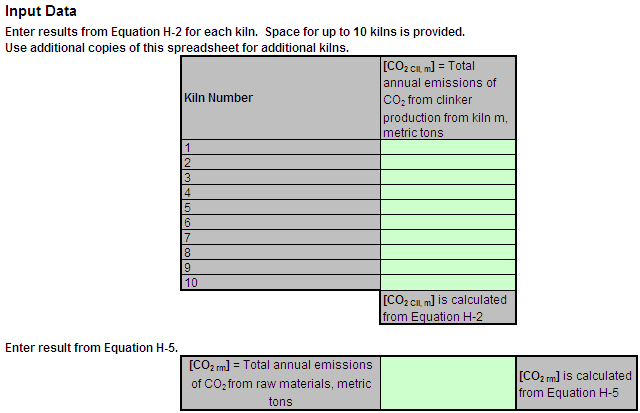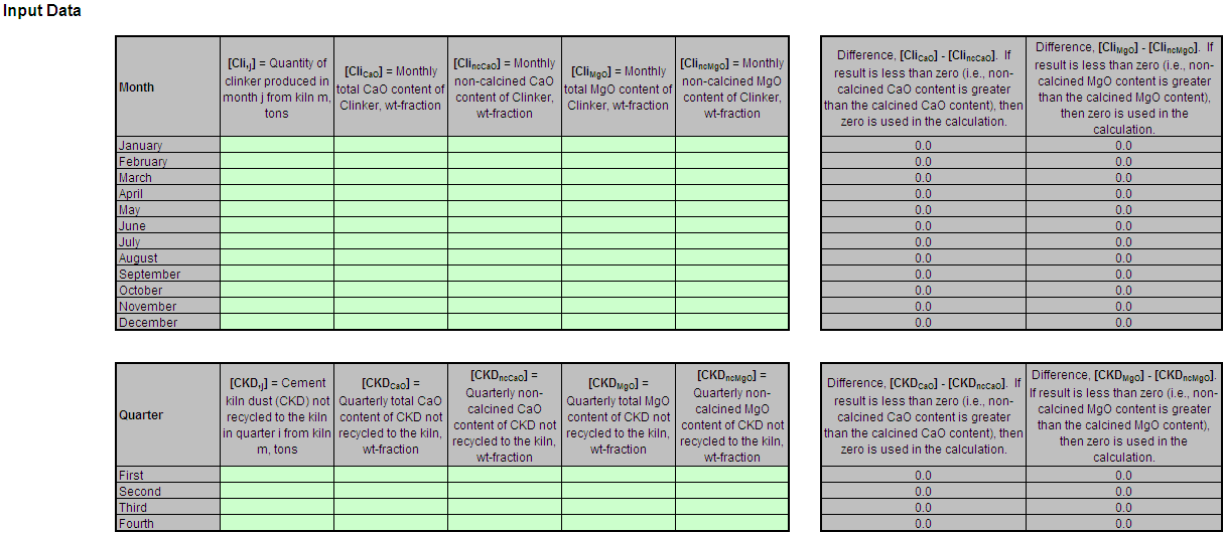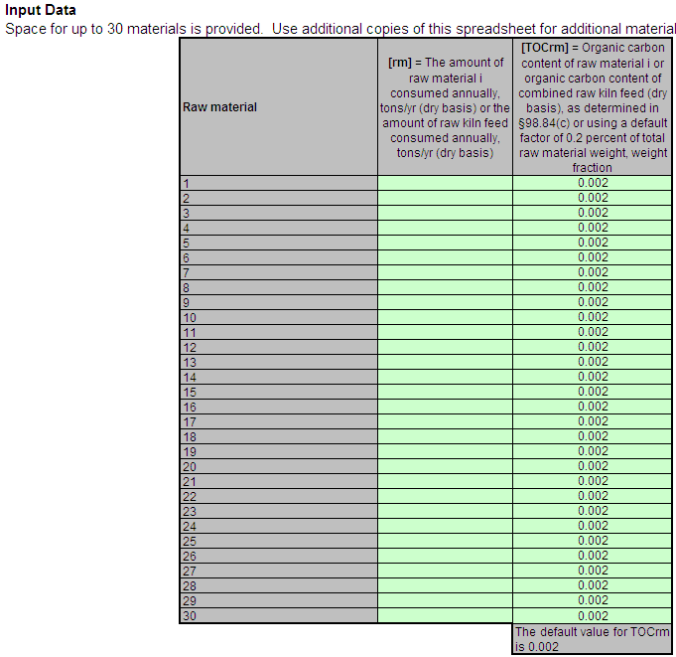These optional spreadsheets are provided to assist reporters in calculating emissions and in keeping records of these calculations.
Reporters are required to keep records of these calculations under 40 CFR 98.3(g) and additional subpart-specific provisions, but are not required to use these spreadsheets or to submit any spreadsheets to EPA.
Overview
This help page provides guidance for working with the supplemental Subpart H calculation spreadsheets. The guidance provides step-by-step instructions for the following tasks:
- Understanding the Flow of Subpart H Calculation Spreadsheets
- Downloading a Calculation Spreadsheet
- General Information on Using a Calculation Spreadsheet
- Using the Equation H-1 Calculation Spreadsheet
- Using the Equation H-2, H-3, H-4 Calculation Spreadsheet
- Using the Equation H-5 Calculation Spreadsheet
Specific information on each of the spreadsheet tools is provided below:
Calculation Spreadsheet | Unit | Calculation | Instructions |
|---|---|---|---|
All kilns | Total CO2 from Cement Production | ||
Single kiln | CO2 from Clinker Production | ||
Single kiln | CO2 from Raw Materials |
Subpart H requires a facility to report annual CO2 process emissions from cement production for all kilns. To calculate these emissions, users must use the five equations displayed below:
(Equation H-1) | |
|---|---|
(Equation H-2) | |
(Equation H-3) | |
(Equation H-4) | |
(Equation H-5) |
Equations H-2, H-3, H-4, and H-5 calculate results for a kiln that are subsequently used in Equation H-1. Three different calculation spreadsheets must be used to calculate the total annual CO2 process emissions from cement production for all kilns (Equations H-2, H-3, and H-4 are grouped into a single calculation spreadsheet). Users should first complete calculations using Equation H-2, H-3, H-4 Calculation Spreadsheet and Equation H-5 Calculation Spreadsheet for each kiln and then enter the results for each kiln into the Equation H-1 Calculation Spreadsheet to calculate the total annual CO2 process emissions from cement production for all kilns.
Calculation spreadsheets for Subpart H may be downloaded by clicking one of the links in the first column of the table below. Users may also jump to instructions for each calculation spreadsheet by clicking one of the links in the third column.
Calculation Spreadsheet | Unit | Calculation | Instructions |
|---|---|---|---|
All kilns | Total CO2 from Cement Production | ||
Single kiln | CO2 from Clinker Production | ||
Single kiln | CO2 from Raw Materials |
The guidance provided in this section applies to each of the calculation spreadsheets for Subpart H. Additional guidance is provided for each individual calculation worksheet in the sections below.
Color coding
The calculation spreadsheets contain green input cells, gray informational cells, and red-bordered results cells filled with yellow or white. Users should use green input cells to enter all data specific to their facility, unit, or process. Gray informational cells contain parameter names, column and row headings, equation constants and subtotals. Calculation results are displayed in red-bordered results cells filled with yellow or white. For red-bordered, yellow-filled results cells, the values in these cells should be entered in the appropriate and separate calculation spreadsheet (as directed below cell) where additional calculations will be made. For red-bordered, white filled results cells, the values in these cells should be entered in e-GGRT for the appropriate process units. All cells that are not green input cells are locked and cannot be modified.
|
Green input cell (data entry) |
|
Gray informational cells (locked) |
|
Red-bordered, yellow-filled results cells (enter in appropriate and separate calculation spreadsheet) |
|
Red-bordered, white filled results cells (enter in e-GGRT) |
Stop and Warning Messages
The calculation spreadsheets will display a stop message if the user enters a value that is invalid or a warning message if the user enters a value outside the EPA estimated range for a particular data element. For invalid data entries, the stop messages will not allow a user to proceed and the user must reenter valid data before moving forward. For data entries that are outside the EPA estimated range for a particular data element, the warning messages will allow a user to proceed if the user deems the entered value to be accurate.
Users with multiple kilns should use separate calculation spreadsheets for each kiln. Users should not aggregate data from multiple kilns until requested to do so in the Equation H-1 Calculation Spreadsheet.
Use this spreadsheet to calculate total annual CO2 process emissions from all kilns used in cement production. Calculated results from the Equation H-2, H-3, H-4 Calculation Spreadsheet and the Equation H-5 Calculation Spreadsheet are required as inputs to the Equation H-1 Calculation Spreadsheet. Be sure to complete the Equation H-2, H-3, H-4 Calculation Spreadsheet and the Equation H-5 Calculation Spreadsheet before beginning work on the Equation H-1 Calculation Spreadsheet. Equation H-1 is provided below.
(Equation H-1) |
|---|
Begin by entering the facility name, your name, the reporting period, and any additional comments in the green input cells of the general information table located immediately below the equation in the calculation spreadsheet. This is for your records.
Next, enter the requested information from the Equation H-2, H-3, H-4 Calculation Spreadsheet and the Equation H-5 Calculation Spreadsheet in the green input cells of the Input Data table.
The H-1 calculation spreadsheet will calculate the total annual CO2 process emissions from cement production for all kilns. The calculated value will be displayed in a red-bordered cell with white fill at the bottom of the spreadsheet. This value should be entered in e-GGRT for this facility.
Use this spreadsheet to calculate the annual CO2 emissions from clinker production for each kiln by first using Equations H-3 and H-4 to calculate emission factors which are then used in Equation H-2 to calculate emissions. Equations H-2, H-3, and H-4 are provided below.
(Equation H-2) | |
|---|---|
(Equation H-3) | |
(Equation H-4) |
Begin by entering the facility name, your name, the unit (e.g. kiln) name or identifier, the reporting period, and any additional comments in the green input cells of the general information table located immediately below the equation in the calculation spreadsheet. This is for your records.
Next, enter the requested information in the green input cells in the Input Data table for a given unit or kiln.
The spreadsheet will calculate the annual CO2 process emissions from clinker production for a single kiln. The calculated value will be displayed in a red-bordered cell with yellow fill at the bottom of the spreadsheet. This value should be entered into the Equation H-1 Calculation Spreadsheet.
this spreadsheet to calculate the total annual CO2 emissions from raw materials used in cement production. Equation H-5 is provided below.
(Equation H-5) |
|---|
Begin by entering the facility name, your name, the reporting period, and any additional comments in the green input cells of the general information table located immediately below the equation in the calculation spreadsheet. This is for your records.
Next, enter the requested information in the green input cells of the Input Data table for a kiln.
The spreadsheet will calculate the annual CO2 emissions from raw materials used in cement production. The calculated value will be displayed in a red-bordered cell with yellow fill at the bottom of the spreadsheet. This value should be entered into the Equation H-1 Calculation Spreadsheet.


















